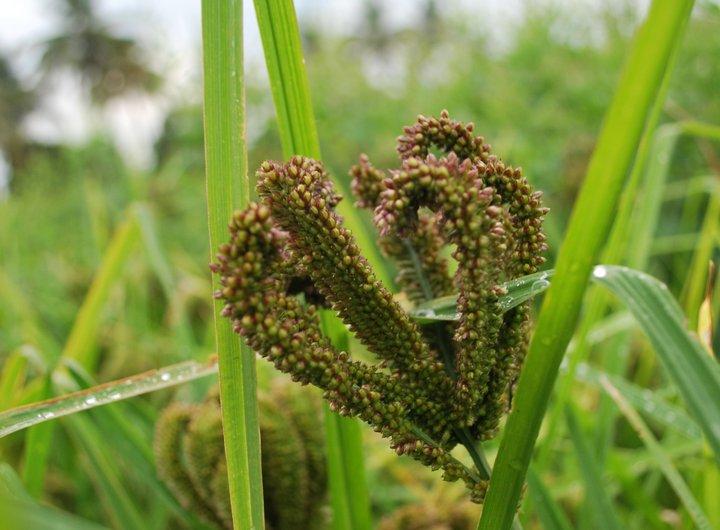Millet revolution in India: Let's keep up the momentum!

Over 15 years of promoting millet use and conservation is paying off. Research fellow Gennifer Meldrum reports from Chennai, India as Bioversity International and partners are taking the initiative to the next level.
By Gennifer Meldrum, Research Fellow, Nutrition and Marketing Diversity
Millets are truly on the rise in India.
Fifteen years ago, it was unimaginable for restaurant owners to include millets on their menus but today in the city of Namakkal alone there are at least three restaurants with a mission to serve healthy millet-based foods.
Dr Dayakar Rao (Indian Institute of Millets Research) recalls that it was difficult to find even one private company making processed millet products ten years ago, whereas today there are plenty. Demand for millet is increasing in high-end organic markets, while their entry in the public distribution system with the National Food Security Act (2013) also means the poor are gaining greater access to these nutritious cereals via subsidized rates.
This tangible progress toward diversifying the food basket of India has been catalyzed in no small part by the research and advocacy of the M.S. Swaminathan Research Foundation (MSSRF). The efforts of this organization and its charismatic leader have carried through several initiatives, including a Bioversity International-led project on neglected and underutilized species. Over nearly 15 years, the project partners have worked to promote millet use and conservation in close collaboration with the farmer custodians who safeguard these 'life-saving crops', as Dr Stefano Padulosi, Global Project Coordinator, refers to them.
The closing meeting for this project was held last week (17-18 February 2015) in Chennai to share results and discuss the way forward to continue mainstreaming millets in India and beyond. Dr Swaminathan reflected on just how much this initiative has achieved: “This project, which is unfortunately ending, has really been catalytic to trying to get public understanding, political understanding, and scientific understanding for the need for attending to these crops”. The Professor noted that while the project may be ending, the work must not! “As far as India is concerned we must ensure a lot of new developments... We must ensure we keep up our interest in these crops in the national interest in the interest of farmers and in the interest of food security”.
Millets are gaining popularity but there are still many issues to be addressed to realize robust value chains and rescue these species from obscurity. Several speakers noted that farmers want to grow millets but the seed is not available. Processing machinery also continues to be a major bottleneck, particularly for species with multiple hard seed coats. Fairly compact and affordable models for polishing little millet and foxtail millet have been developed through the project but machines for processing barnyard millet and kodo millet are still lacking.
Strong promotion and marketing are also needed to attract consumers. Dr Swaminathan commented that “labelling is a very good idea” to signify that “this is a product of conservation by the Kolli Hills community” or another community. He noted that such a label would be complementary to a system for monitoring the status of cultivated species similar to the IUCN Red List.
Refining the National Food Security Act to distinguish minor millet species from major millets and maize (currently lumped together as 'coarse grains') was observed by some participants to be an important action to ensure proper attention is given to the strategically important minor millets. Dr Oliver King, Principal Scientist at MSSRF, explained that this policy is just beginning to be implemented and the price farmers will be offered for their millet is yet to be determined. Various participants cautioned that if the price is too low then farmers will not be motivated to sell to the public system when private traders offer a better price. A fair compensation rate could thus be critical to ensure the benefits of these crops reach the poor and not just wealthy health-conscious consumers. The urgent need for consultation with farmers to determine an acceptable price was highlighted by Oliver King as a vital and urgent step towards implementing this promising new policy.
- See photographs from the Chennai meeting here
- Read 'a further blog post on this meeting on NUS Community Website here
The project on neglected and underutilized species supported by the International Fund for Agricultural Development (the IFAD-NUS project) has taken place over four phases over the last fifteen years in India, with support also from the CGIAR Research Program on Climate Change Agriculture and Food Security (CCAFS) and the European Union. In the most recent phase the focus has expanded from Tamil Nadu and Orissa to Uttarakhand and Madhya Pradesh working with MSSRF, Gene Campaign and Action for Social Advancement. The project has also been involved in Nepal and Bolivia, where closing meetings have also taken place this month.
